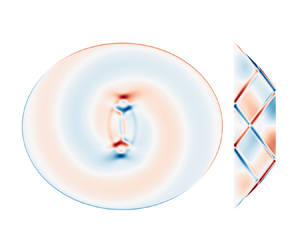Article contents
Inertial wave super-attractor in a truncated elliptic cone
Published online by Cambridge University Press: 26 January 2024
Abstract

We consider inertial waves propagating in a fluid contained in a non-axisymmetric three-dimensional rotating cavity. We focus on the particular case of a fluid enclosed inside a truncated cone or frustum, which is the volume that lies between two horizontal parallel planes cutting an upright cone. While this geometry has been studied in the past, we generalise it by breaking its axisymmetry and consider the case of a truncated elliptic cone for which the horizontal sections are elliptic instead of circular. The problem is first tackled using ray tracing, where local wave packets are geometrically propagated and reflected within the closed volume without attenuation. We complement these results with a local asymptotic analysis and numerical simulations of the original linear viscous problem. We show that the attractors, well known in two dimensional or axisymmetric domains, can be trapped in a particular plane in three dimensions provided that the axisymmetry of the domain is broken. Contrary to previous examples of attractors in three-dimensional domains, all rays converge towards the same limit cycle regardless of initial conditions, and it is localised in the bulk of the fluid.
JFM classification
- Type
- JFM Papers
- Information
- Copyright
- © The Author(s), 2024. Published by Cambridge University Press
References
Favier and Le Dizès supplementary movie 1
Favier and Le Dizès supplementary movie 2
- 4
- Cited by



